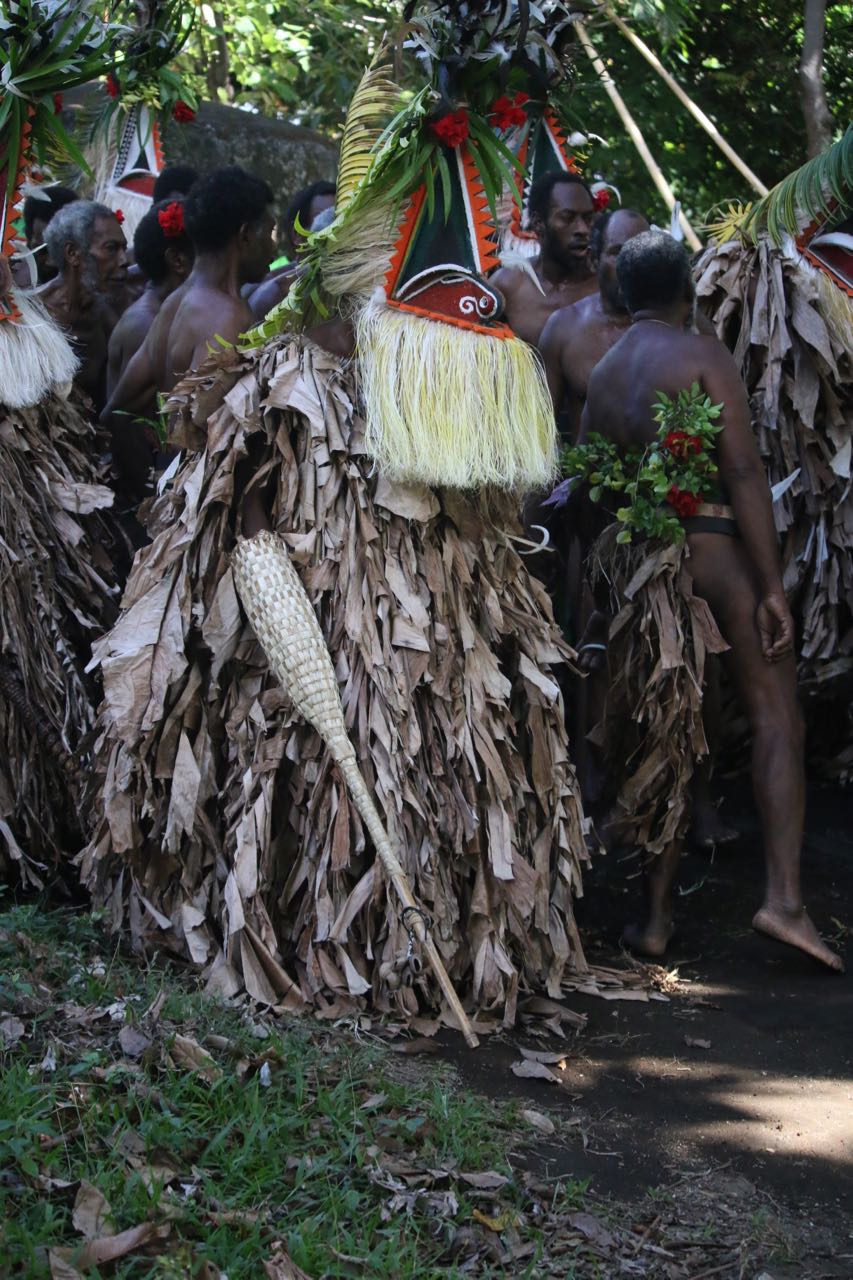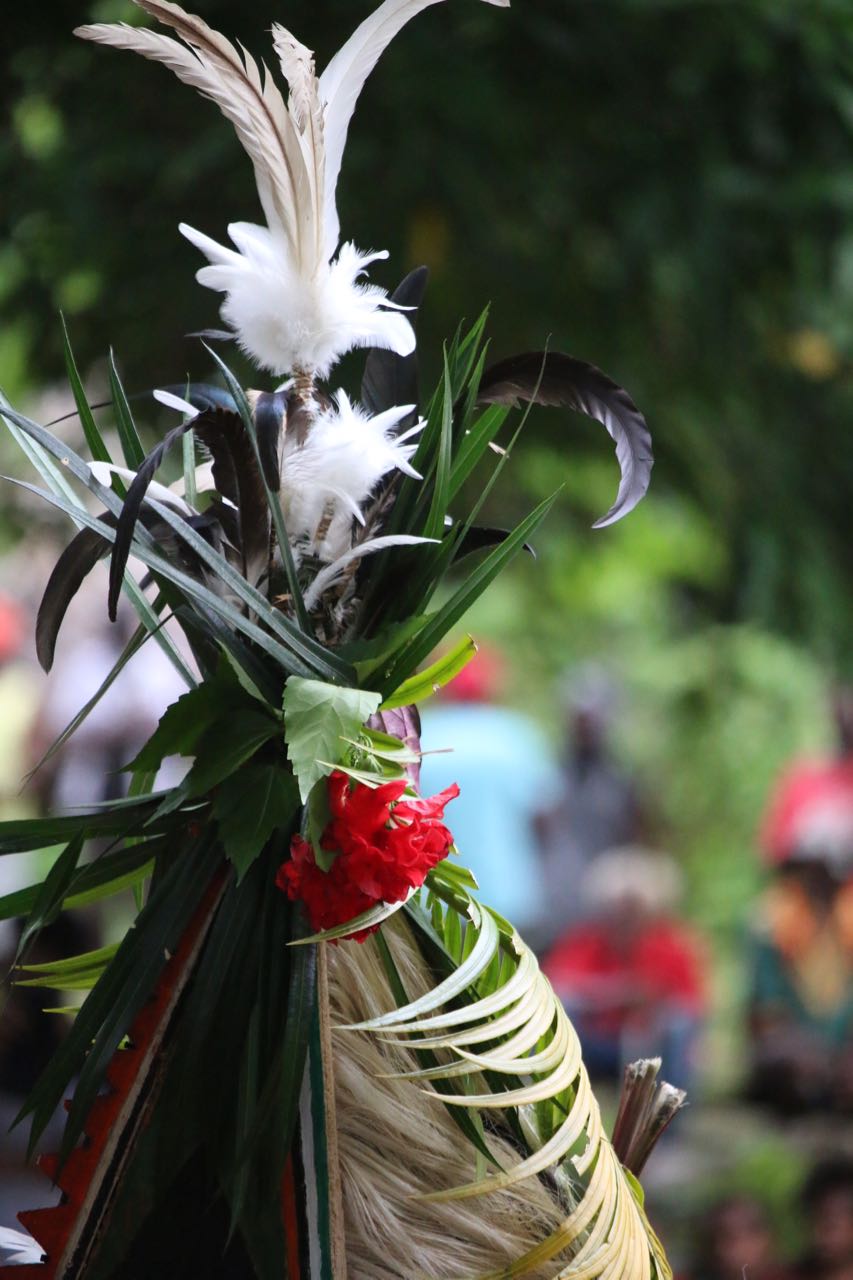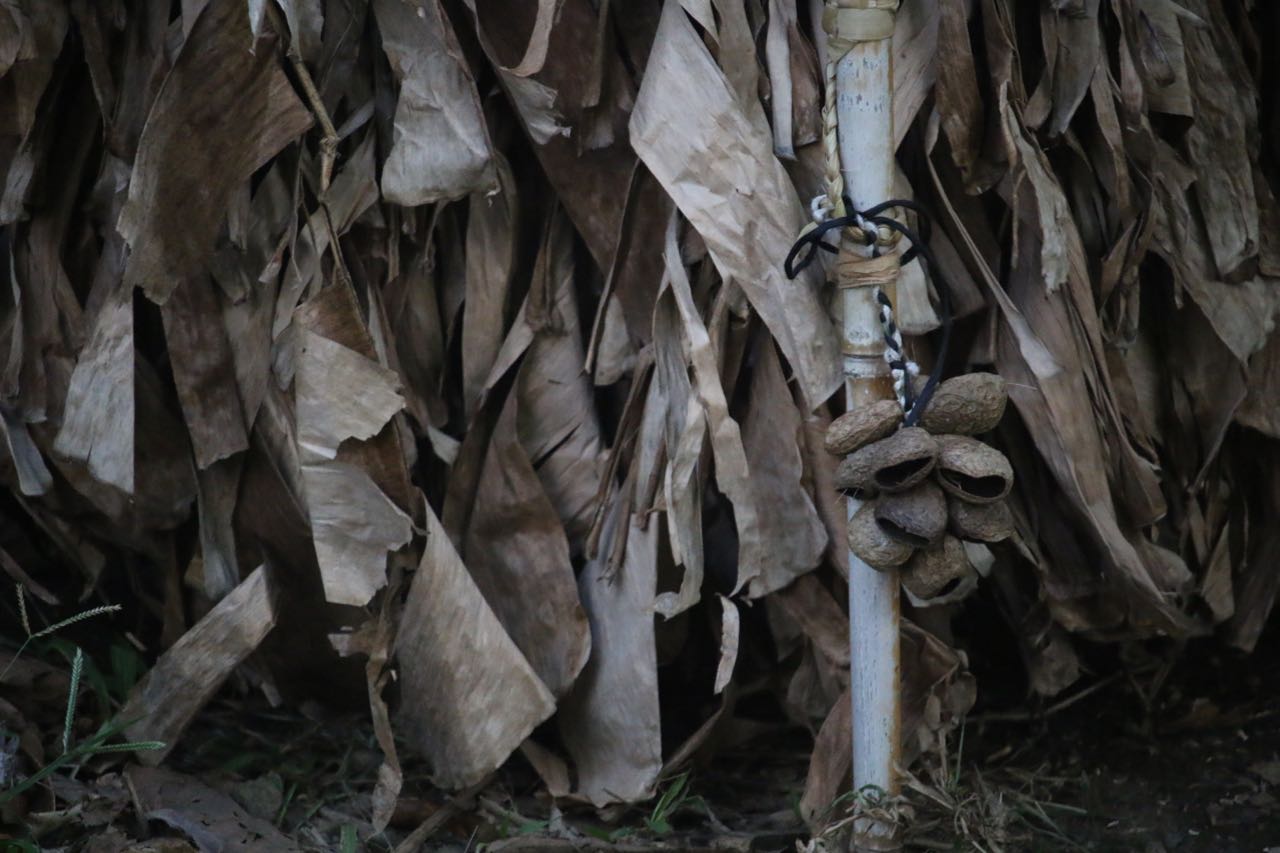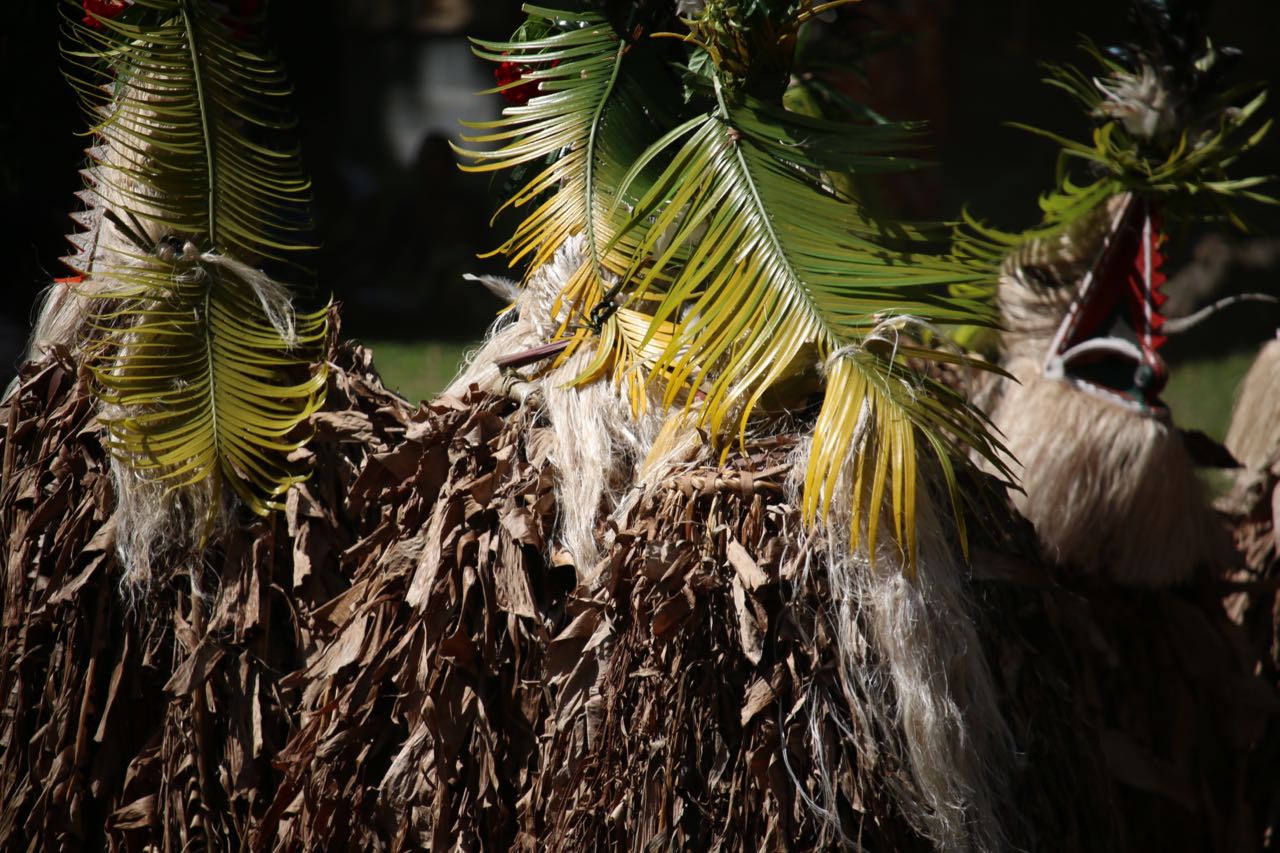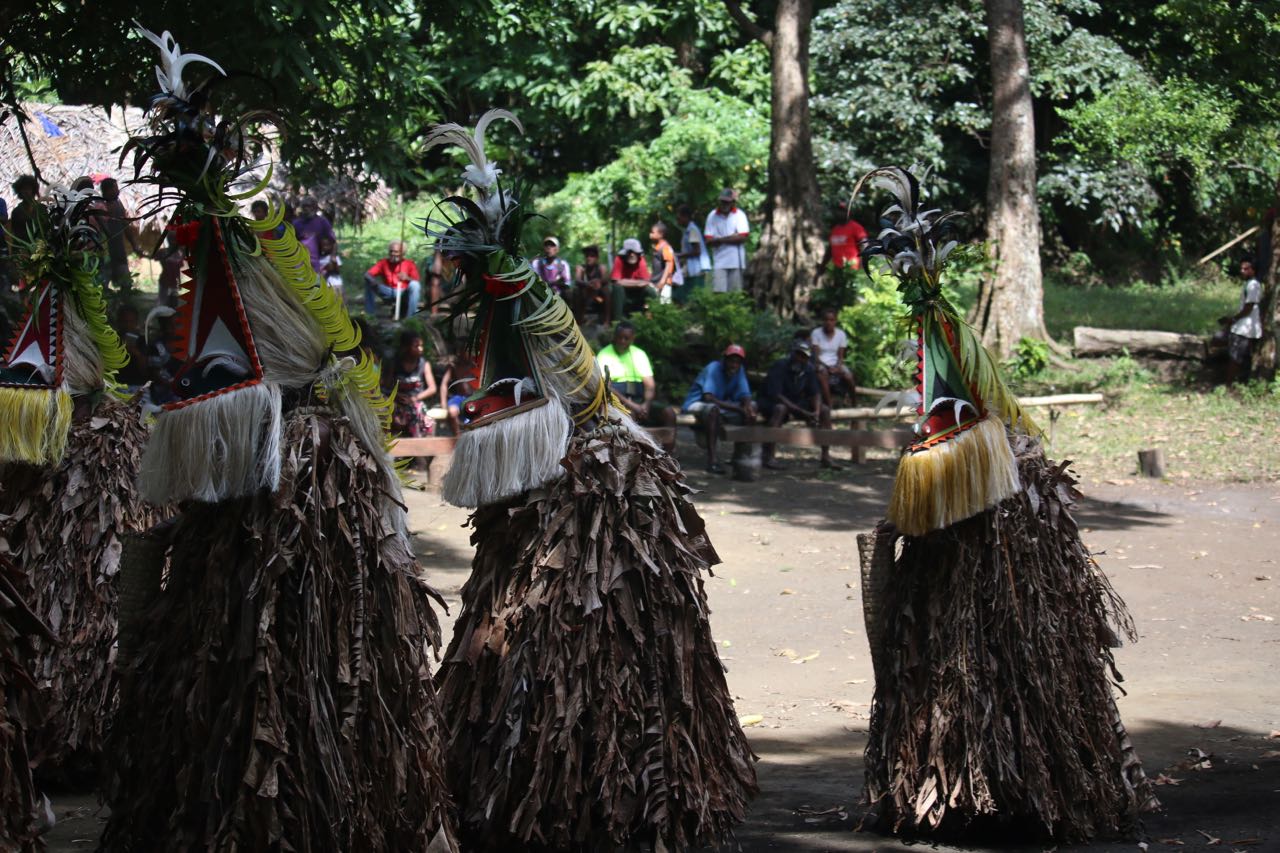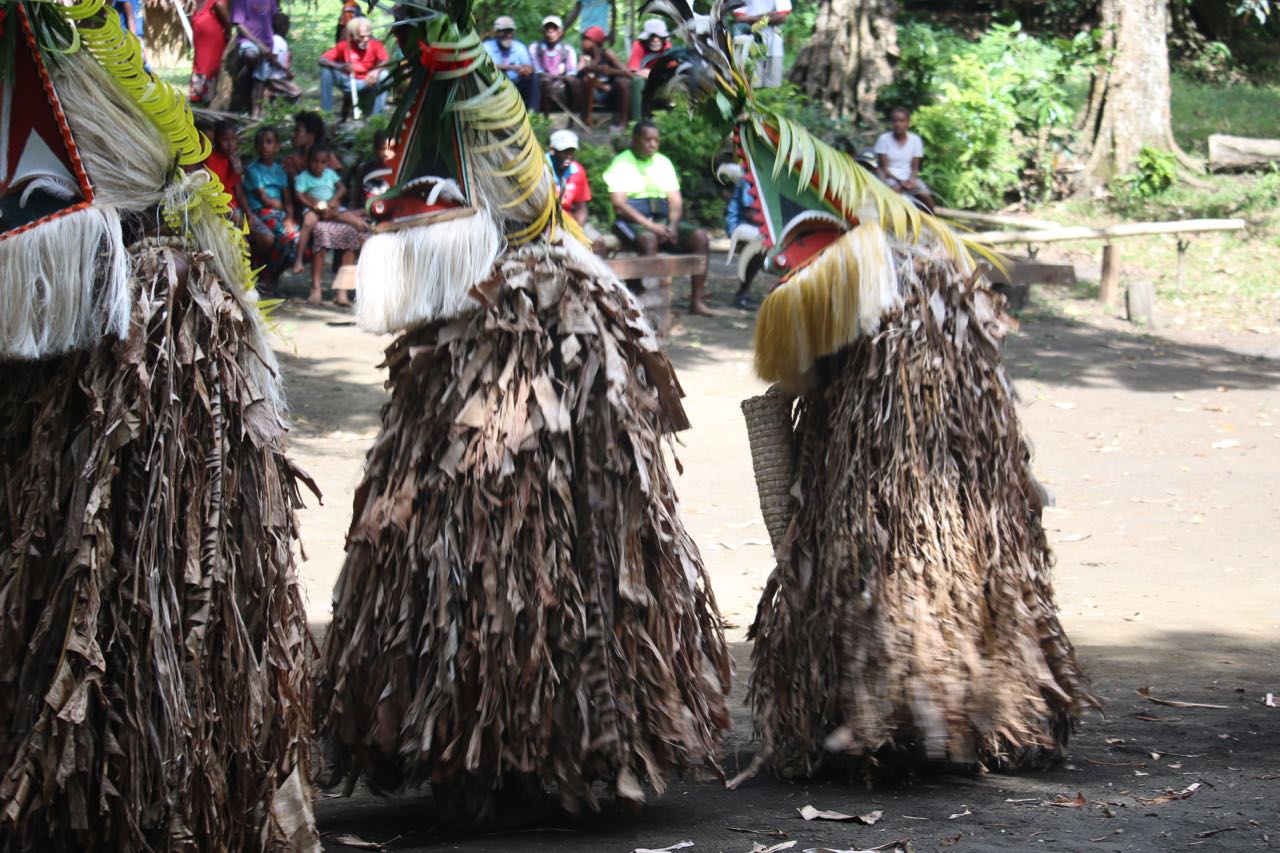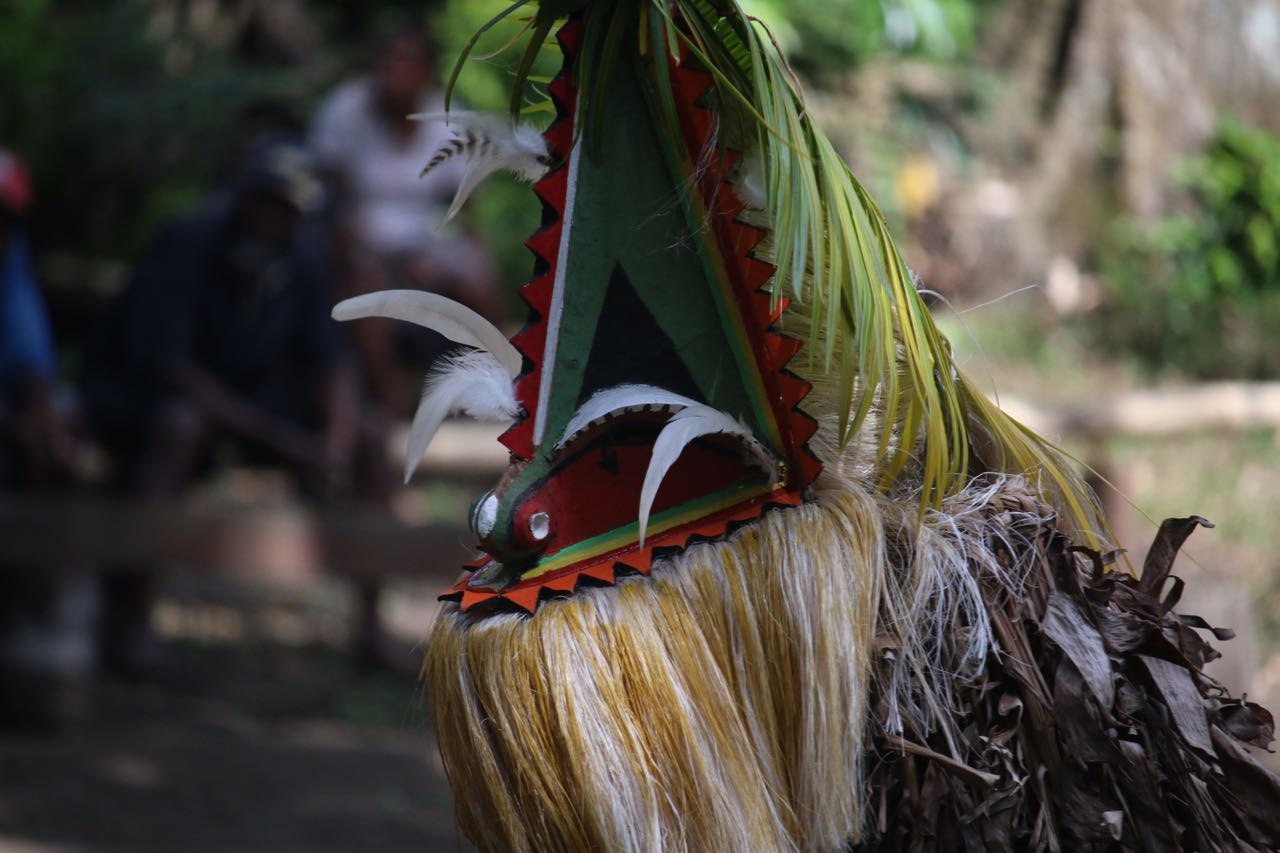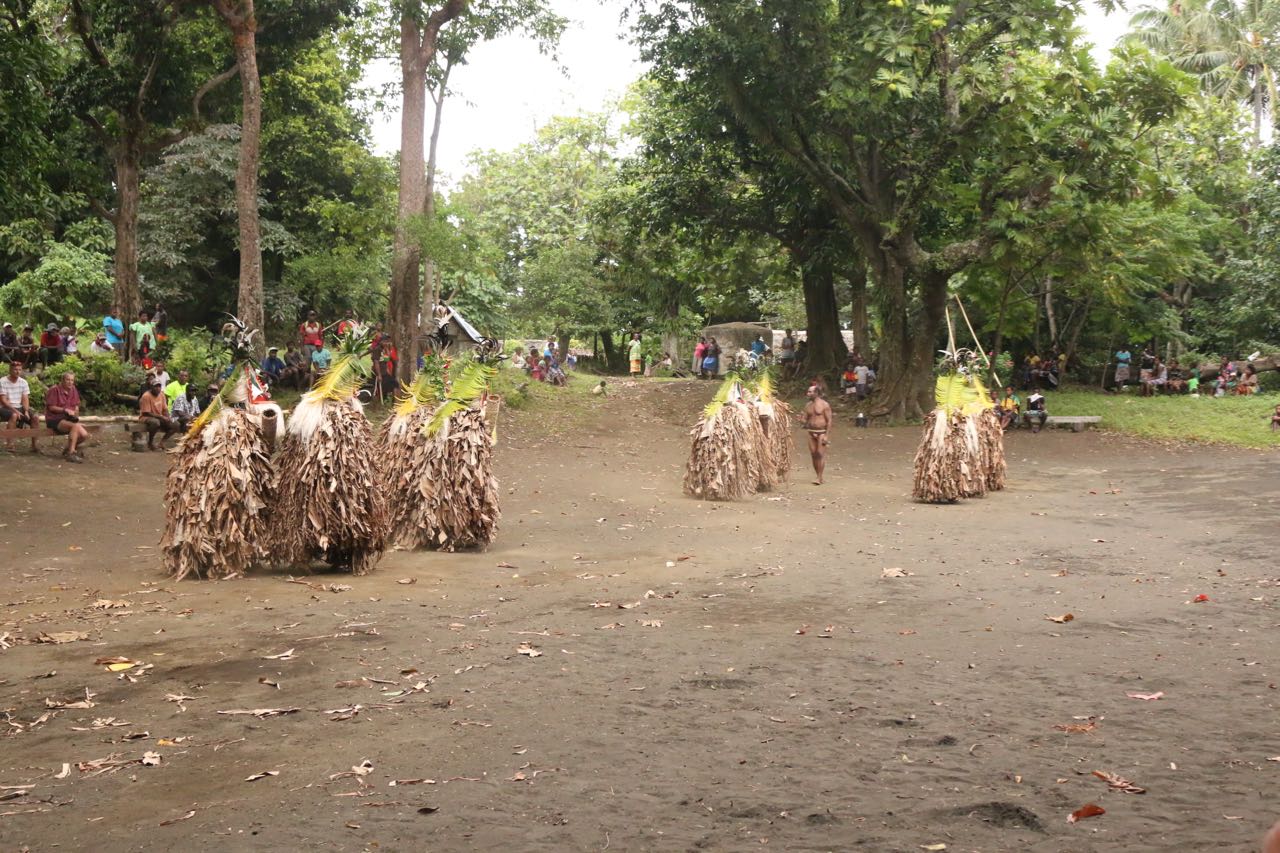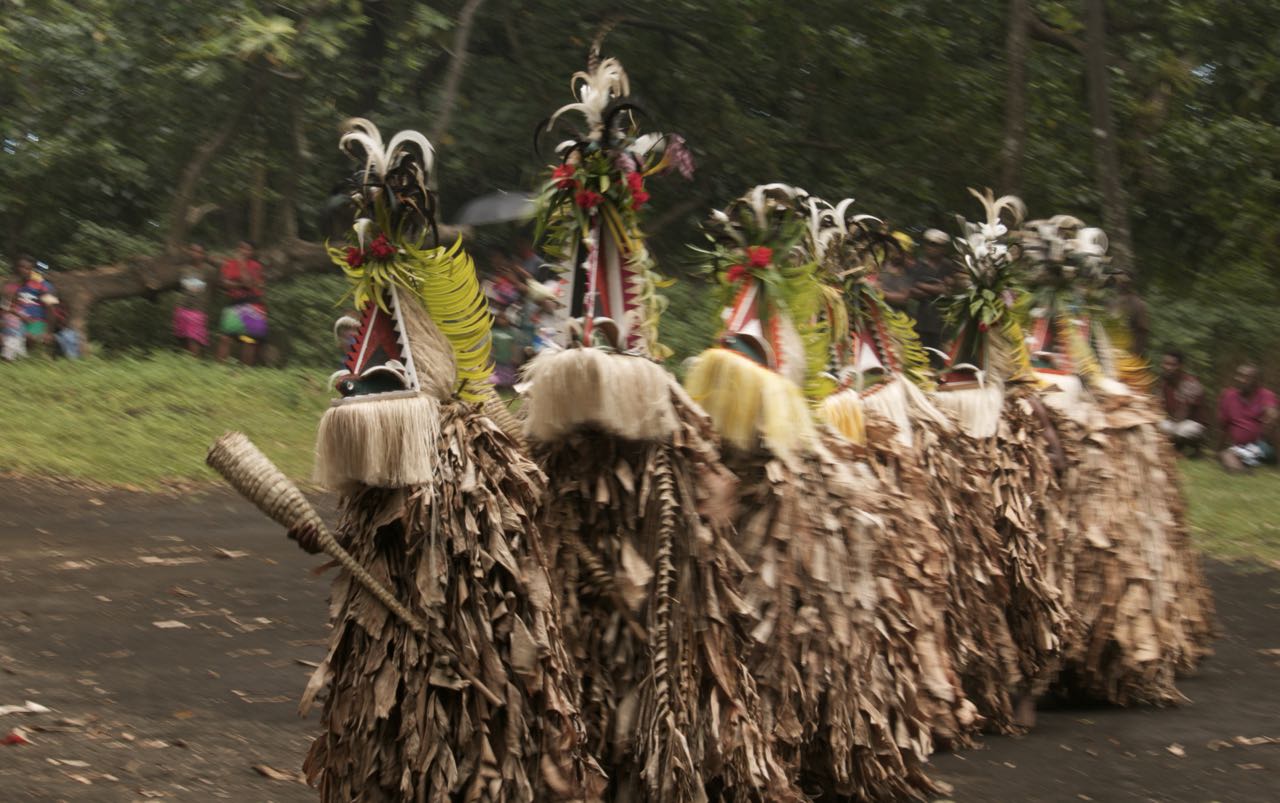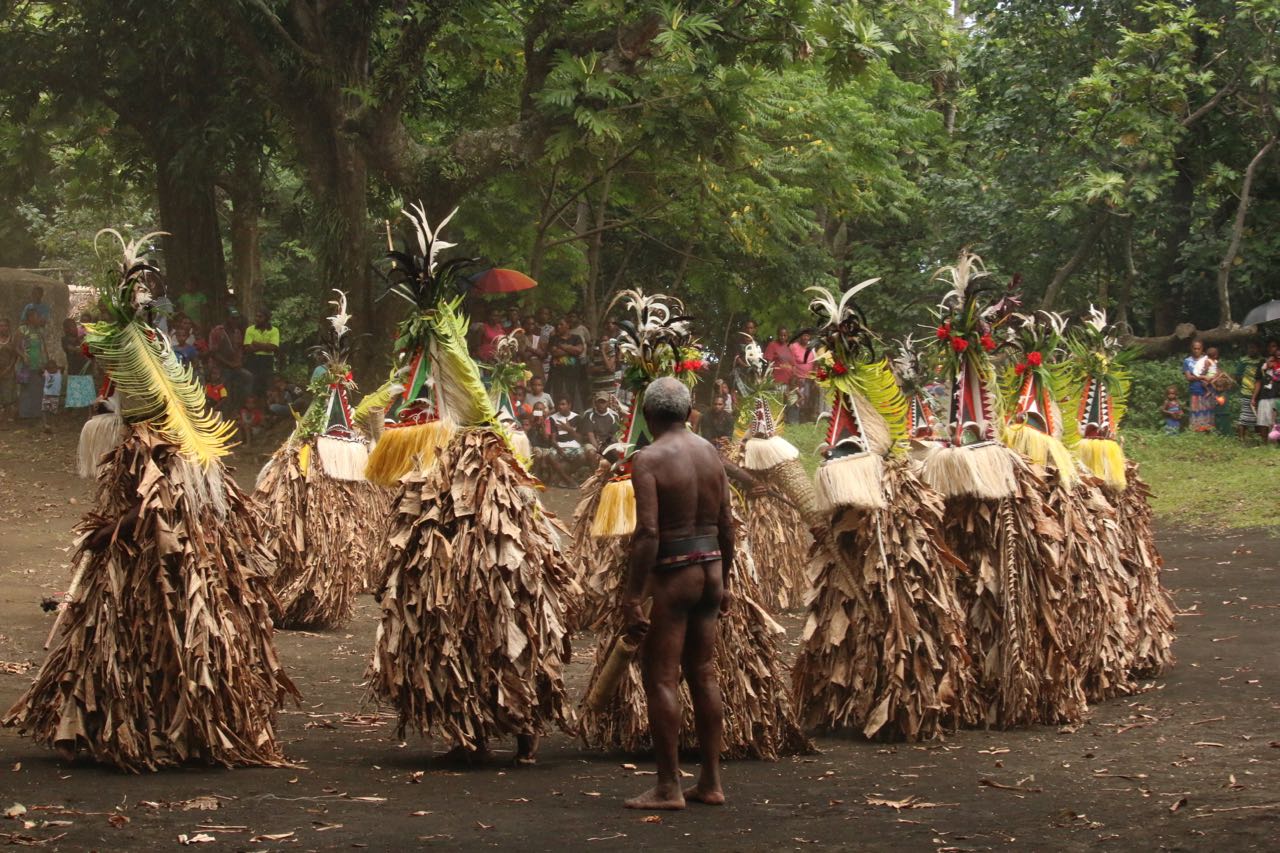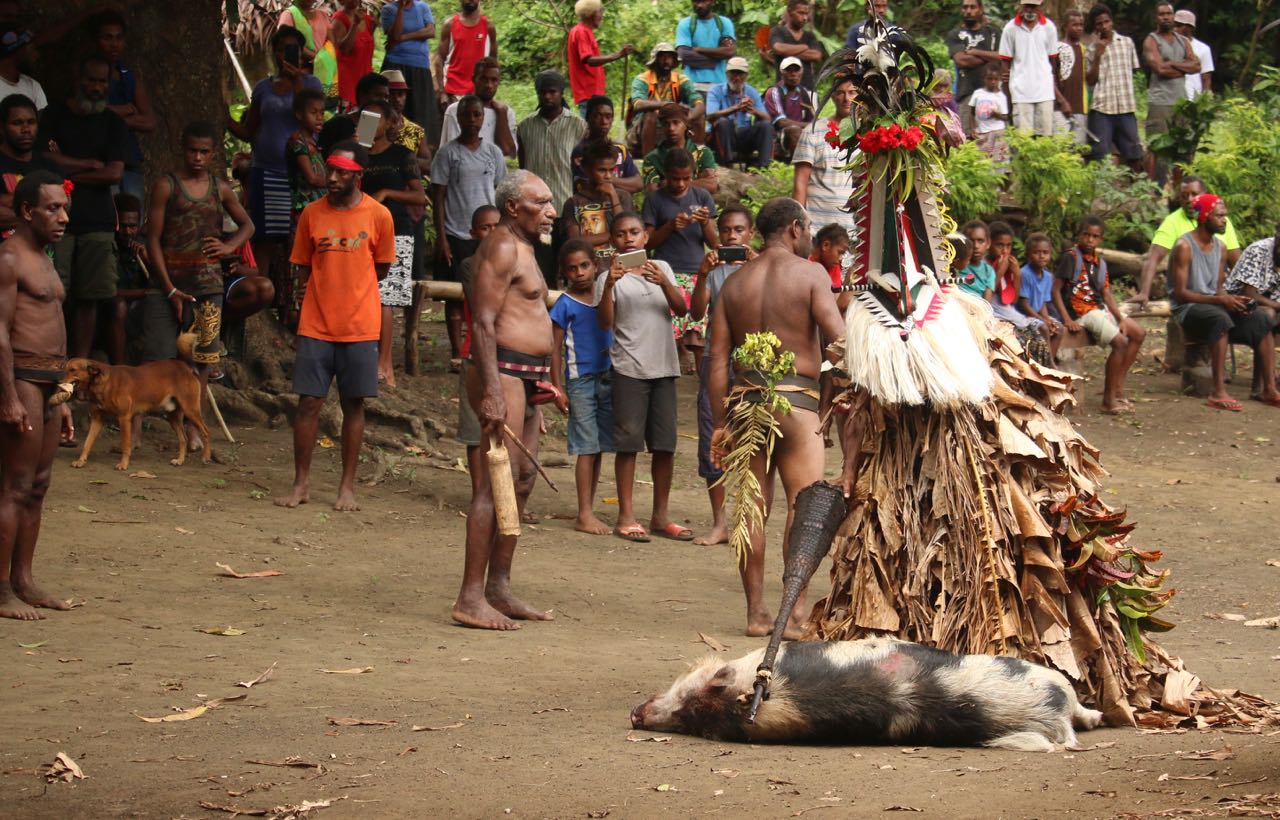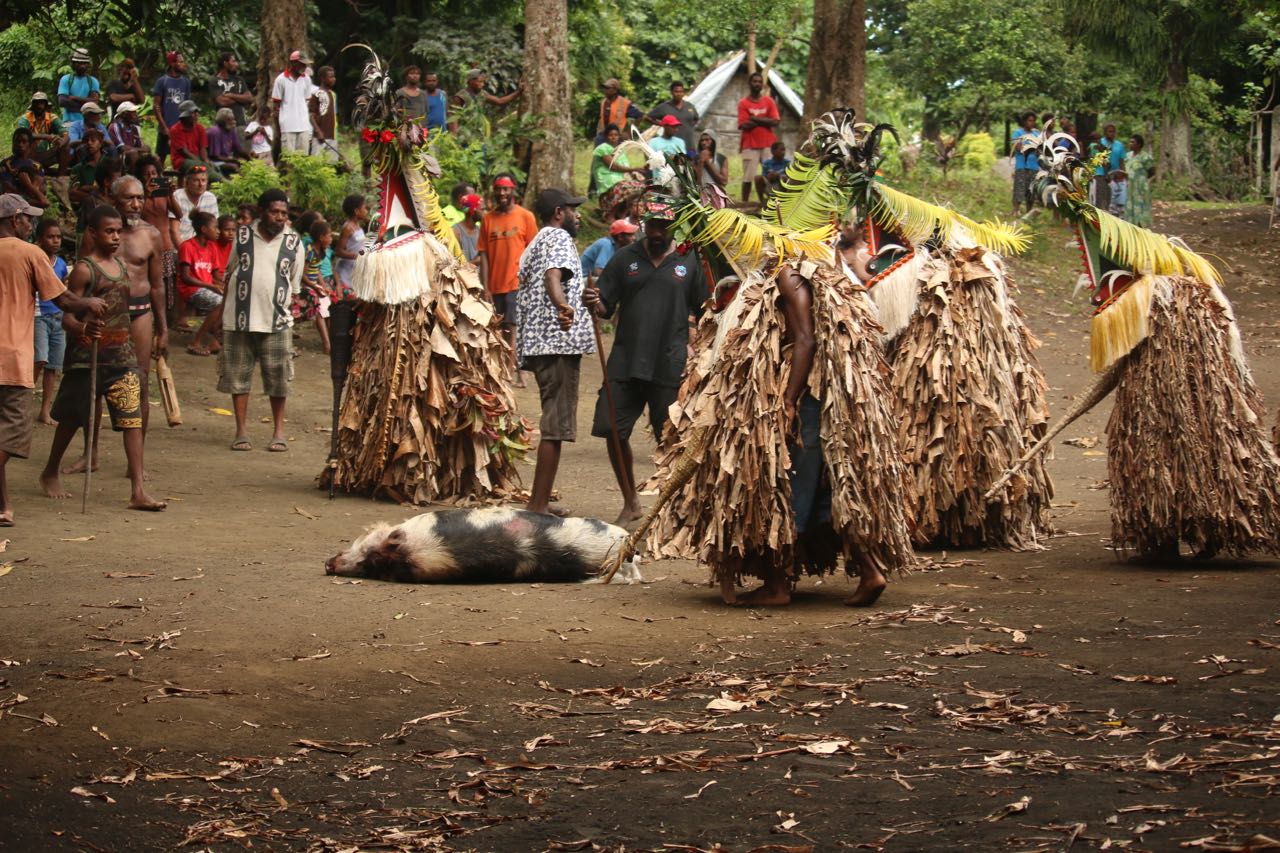A warning to sensitive readers: This post describes the ceremonial killing of pigs and contains two images of pigs involved.
After festival night #1, we watch the billowing glow of the volcano and sip a glass of wine in Sonrisa's cockpit. Then, I drift off to sleep. I dream of stomping feet, powdered black by dust burped from the belly of the earth. The masks stare at me through the throng of dancing men. If the eyes are windows to the soul, these hollows must lead must into the center of the universe.
Our expectations for the Rom Dance have been building for the last month. Before we left Port Vila, one of our friends hailed from Ambrym. She looked into my eyes and put her hand on my arm: “Whatever you do, do not touch a Rom Dancer. They are spirits. You must not touch them.”
“Okay.” I tell her, nodding to match her sincerity.
“If you do, you will have to kill a pig.”
I do not want to kill a pig. “I will not touch a Rom Dancer.” I say.
On day two of the Fanla Festival, the same fleet of dinghies flocked to shore. No one left disappointed the night before. We take the ride in the Indiana Jones truck, and arrive back at the line of chairs in the village square to wait until all is ready.
“Clack…clack…clack…clack…clack…clack….” An eerie echo from a distance, hollow rattles sound to the beat of walking footsteps. They grow louder as they get closer, the swish of dry foliage layers on top of the instrumentation. The spirits are otherwise silent, and we sailors fall to a hush as well.
The Rom emerge from behind the woven huts. Two long lines, the spirits are clothed in crisp, brown banana leaves, topped with fearsome, colorful masks. They wear beards, their hair is long, honey colored strands, covered by a dragon’s mane of fern. Their hair adorned with chicken feathers and a blood red flower. They command attention.
William tells us we are to move into the Village Center, a bit down the road. With this small permission, the sailors chitter with excitement and awe. Some of us follow Willam’s lead down and away from the Rom. Others, who do not have the benefit of Marie’s wisdom approach the Rom and get close to take pictures. William turns back to check his flock and cries with concern “DO NOT TOUCH THE ROMS! STAY BACK! DO NOT TOUCH THE ROMS! YOU MUST STAY BACK!”
The two rows of Rom stop at the top of a long road, a distance away from the village square. The Village Leaders circle up in the center, an elder begins a slow beat on his tam-tam drum. A new chant, slow at first, builds until rounds of “WHAAY_OOOOOHHHHH! WOP! WOP!” spiral around each other like the dancers themselves. The Rom dancers clatter and swish like human sized snare drums. The group makes their way down the road, but slowly. It takes a solid hour to sing, stomp, and rattle their way to the center of the village.
When they reach their destination, silence befalls the square. The Rom Dancers wait. Two elders take their position at two larger than life carved drums. During the silence, William explains the Rom are the embodiment of evil spirits and the dance is an interpretation of the forces of good and evil. The elder begins tapping the drum, one beat per second, the sound of hollow wood. The lines of Rom begin bopping.
I realize that “bopping” is probably not the proper way to describe the movement of an evil spirit, but I stand by my description. In this phase of the dance, the Rom lean forward a little bit, jutting their masks forward and “bop” their heads right, left, right, left.
Every now and then, a Rom peels away from the rest of the group and disappears into town. His dragon mane dragging through the dust in the mysterious manner dragon manes do.
“Where is he going?” I ask William.
William explains that the masks are heavy and the way they attach to the dancer’s head interrupts his breathing. When they get a little woozy, they need to scurry off to recover. I imagine a whole line of Rom toppling on top of each other due to asphyxia.
Soon, the errant Rom returns and joins his brethren looking fresh as a daisy.
The Rom split into two groups, one on each side of the square. They begin weaving through themselves, a long snake eating its own tail. They spiral and circle among each other. Every now and then, a Rom finds himself out of sync or out of line. He is soon caught, reprimanded by the Chief’s son, next in line to the throne. How does one err in his work as an evil spirit? I wonder what is being said.
Like ballet mothers shuttling ducklings in pink tutus to the front of the stage, the Chief’s right hand men hover over the Rom, guiding them in the way to go. The Rom work hard to stay in formation, but every now and then I spy one cheating. One Rom clings to a banana frond from the body of the Rom in front of him, making it easier to follow.
William chuckles and says “These guys need some practice! It’s hard to see through the masks, though.”
“Why are they evil spirits?” I ask William, they seem friendly enough. He explains that their role within the society is primarily to enforce custom practices. Villagers were told if they failed in their duties to keep their custom rituals, evil spirits would rise to punish and haunt the village. If a particular egregious violation occurred, the Rom would visit the village in the night, seek out the offending party and punish them accordingly.
“What is the stick for?” I asked William.
“To beat people.” He says, looking straight ahead, watching the dance.
I look around the square. I imagine lying in my woven hut, only the light of a silver moon pressing through pinholes in my bamboo wall, hearing the swish and rattle of a Rom approaching. The Rom is coming to punish an infraction, realign compliance with arbitrary rules based in superstition. Will this ward off famines or cyclones? Do the Rom have a sense of compassion or justice? Did they take evidence before paying a visit? The villagers are here watching, but even as they raise their IPads and Cell Phones to video, they keep their distance.
Those with the dark black sticks are the most powerful Rom. Those with the white sticks are beginners. Beyond these few facts we learned, Rom are shrouded in mystery. This is by design. No one knows how their bodies or masks are made except the men who make them. Once the costume's use is complete, they must be destroyed. Museums and anthropologists have a hard time acquiring the costumes because the Ni Vanuatu believe that if the costumes and masks are not destroyed, the evil spirit may possess the body of the dancer and remain to haunt the village.
“What happens if you see a Rom being made?” I ask William.
He shakes his head and hums a little. “It is strictly taboo to see how a Rom is made without the right to do so. If you touch a Rom, or if you see a Rom mask or body being constructed or put on the bodies of the dancers, you will be punished.”
“Even the tourists?” I say.
“Even the tourists.”
What is the punishment? The Peeping Tom must purchase a pig and he will be whipped with a stinging plant that lasts for days. I stick close to William to avoid any inadvertent Rom viewing.
“How do the men in the village earn the right to be a Rom?” I ask.
“That is next,” William tells me. “They have to pay for the mask, and they have to kill a pig.” William points past the tall drums, to the side of the square. There, I see several pigs literally “hogtied” by all four feet. The largest one has already been killed; several smaller pigs are still alive. They rest in the dust, resigned.
Surely, they aren’t going to kill the pigs in front of us. I wrack my brain to try to remember if “pig killing ceremony” was listed on the flyer.
The Rom complete their dance, then wait. The large pig, already dead, is dragged toward them. The Rom with black sticks take the lead; the first one stands over the pig and ceremoniously touches the body with the end of his stick. Each Rom follows his lead. One by one, they approach the pig, touch it with the stick, then fall away.
The Rom fade away into the village, and they are gone. Was that it? A ceremonial pig killing, that makes sense.
Now, the smallest pig, tied up in the corner senses a darkness in the air. Previously resting in the shade, he struggles to his feet though they are tied. Creating the narrow platform of hooves, he makes it upright but then falls back to his side. Realizing an attempt to stand will fail, he reaches his hooves forward, and uses them to claw himself along; like a person rowing a boat through water, he reaches forward, pulls the dirt toward him, and scoots his body along the dust. He makes headway, only to put himself in the hot sun. The spirit in his eyes is not resigned; he longs to escape.
Next, young men dress up in their best clothes, stand in line and pay cash for the honor to serve as a Rom. The elders take each available mask in hand, and wait for a young man to step forward. Once they confirm he has the proper amounts, the chief steps forward and exchanges one mask for the cash. The young men take their masks into the crowd. “If you look close, each mask has a unique color, pattern, and shape. "The young men pay for the right to make a mask of the same color, pattern and shape as the one he just bought. There is power along with a particular pattern in the mask.” William explains.
The masks are taken away, but the “Paying of rights” is not finished.
"Now they must kill the pig.” William says.
All the live pigs are dragged into the square. They are squealing; they know they are in trouble. One at a time, the young men take up a stick they chose to complete the job. The first raises his stick in the air, and before I can cover my eyes, he brings the stick down on the pig’s head. Collectively, we sailors cry out. Some of us close our eyes. Some of us watch on, feeling light headed. Every one of us grapple with the moral implications of watching a sentient animal being bludgeoned with a stick. With each blow, a dull thud is followed by a screeching that goes straight through your core. Blood starts running from the pig’s ears or mouth. The pig’s body shudders and shakes with a seizure, then finally falls stiff. There are many pigs that must be killed.
I’m holding my camera in my hands, pointer finger on the shutter, but I can’t raise it to my eye. I physically cannot record this experience. The villagers, though, are perfectly comfortable. It’s a fact of their lives; they all have their phones out videoing their brother, nephew, cousin, friend killing his Rom pig.
Some of the young men aim well and are able to end the pig’s life in one or two strikes. Others, struggle. When they struggle, the village laughs. Their focus is not on the pig, but on the mistake made by the man making the kill. “He missed! Ha ha! Better luck next time!” These young men being judged by the entire village; on their detachment, their ability to crush a skull to feed their village - or defend its customs - if a skull need be crushed. It’s not hard to understand that this display is as much a threat as it is a celebration.
About this time, Andrew backs away to sit on a log.
Once the pigs are killed, the village disburses. The celebration is over, and they can all go about their day. The men who killed the pigs now must go clean them and prepare them for the feast.
“And that is the Rights Paying Ceremony!” William announces, spreading his arms wide with a smile on his face. “Now, we will head back to the cooking hut and eat lunch!”
Thirty stunned faces stare back at William with wide eyes. Maybe we weren’t all traumatized, but I would say most of us were. We quietly shuffled back to our lunch spot, mentally processing what we just saw. The crowd murmuring, each with their own take on what just happened. “Whether you bludgeon them with a stick or you pick up a neat cellophane package of pork loin at the grocery, the end result is the same.” “We are really detached from the food we consume.” “Wow. I wonder if you had to kill a pig once per month, per year (?) would you be more desensitized to violence?” “Have you ever been hunting? We are sailors, have you ever fished?” “But isn’t there a quicker way, a less painful way? I put alcohol in the fish's gils to finish him off with a rum cocktail.” Some of us are simply stunned into silence.
After the lunch (no pork was served), we are taken back to the sacred-secret place for one last dance. We are invited to join. I am recovering somewhat from the trauma of the morning, so I kick off my sandals and put my toes in the black volcanic soil. It is silky as baby powder. I circle up facing inward. The Chief’s son motions to me that I should I lean forward and down. The chief begins the chanting, and the dancers begin their stomping. I stand next to Naganunan’s carver, John, who has always been the most voracious stomper. I stomp in time, making sure to pound my feet into the dust as hard as I can physically muster - no soft foot tapping here. John watches my feet, smiles. and gives me the nod of approval.
The whole group is collected on the thumping rhythm of our feet, slow at first and gaining momentum as the song proceeds. We all feeling the same heavy thud through the pads of our feet, upward into our body. Our lives are worlds apart, but right now, we have this one thing in common.



